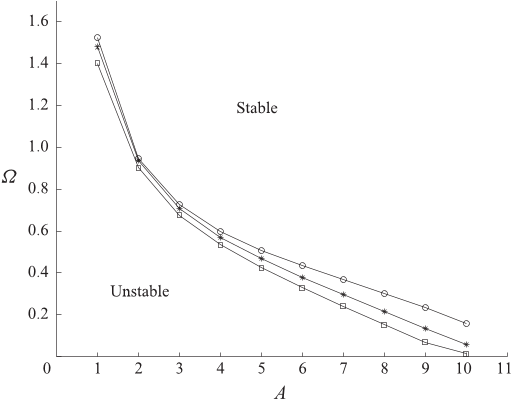




Did you find this useful? Give us your feedback










120 citations
74 citations
...0004 (the same value has been used in [15])....
[...]
...Note that we use a different definition of the surface elevation from the one in [15] where the 1/2 factor is not included (the consequence is that the coefficient in the nonlinear term in equation (2) differs by a factor of 4 from the one in equation (3....
[...]
...In [15] the equation is written in a nondimensional form and the coefficient K = Γ/ω0 is introduced)....
[...]
...We considered the NLS equation discussed in [15]...
[...]
...More recently, the role of dissipation and wind in the modulational instability has been considered together within the NLS equation, [15] (then confirmed by fully nonlinear simulations, [16])....
[...]
70 citations
63 citations
...The case ΓM/ f = O( 2) gives rise to the following damped/forced nonlinear Schrödinger equation [11, 8, 12]...
[...]
...For a logarithmic velocity profile in the boundary layer, the Miles growth rate ΓM results in [4, 7, 8]...
[...]
...The pressure P induced at the water surface then depends on the surface elevation η as follows [4, 8] 1 ρw P(x, t) = ΓM f c(2)p 2π ηx(x, t) (2)...
[...]
41 citations
... (2014). New terms which appear in that modification of the NLS equation may be eliminated after appropriate change of variables, and then the equation turns to the form considered in (Leblanc, 2007; Kharif et al, 2010; Onorato & Proment, 2012). Numerical simulations of individual wave groups affected by wind were performed within different frameworks in (Yan and Ma, 2010; Adcock and Taylor, 2011). Laboratory a...
[...]
1,399 citations
...Following Miles (1957), but within the framework of modulated wave trains, we assume the atmospheric pressure at the interface due to wind and the water wave slope to be in phase....
[...]
...In § 2, the governing equations and the wave amplification theory of Miles (1957) are briefly presented....
[...]
...Miles (1957) developed an alternative derivation of the rate of growth of the wave energy based on a linear stability analysis of the parallel shear flows....
[...]
...We remind the reader that Miles (1957) studied a linear and uniform monochromatic wave train, whereas we are considering a weakly nonlinear modulated wave train....
[...]
...Within the framework of linearized equations, Miles (1957) assumed that the surface elevation and aerodynamic pressure are η(x, t) = aeik(x−ct) and Pa =(α + iβ)ρaU 2 1 kη, respectively, where a denotes the amplitude, k is the wavenumber, c is the phase velocity, α and β are two coefficients…...
[...]
494 citations
388 citations
...The stability of the Stokes’ wave solution started with the work by Lighthill (1965) who provided a geometric condition for wave instability....
[...]
311 citations
...Note that in the case of surface waves generated in wave tanks damping due to viscous dissipation at the lateral solid boundaries must be introduced (see Miles 1967)....
[...]
181 citations
...This case was analysed by Segur et al. (2005a), and it was demonstrated that the modulational instability is restabilized by dissipation....
[...]
...For K < 0, this perturbed NLS equation is similar to the NLS equation considered by Segur et al. (2005a)....
[...]
...Segur et al. (2005a) have confirmed their theoretical predictions by laboratory experiments for waves of small to moderate amplitude....
[...]
...Our aim is to extend the works of Segur et al. (2005a) and Leblanc (2007) who investigated this problem by considering damping and wind effects separately....
[...]
...To study the modulational stability of this solution we follow Segur et al. (2005a) and Leblanc (2007), and we superimpose to the solution (4.1) a small perturbation Ψ = Ψs(1 + δζ (ξ, τ )), (4.4) where δ 1....
[...]
The evolution of a two-dimensional nonlinear wave train on deep water, in the absence of dissipative effects, exhibits the Fermi–Pasta–Ulam recurrence phenomenon.
Since damping affects the modulational instability of waves in deep water, they assumed that it might affect the early development of rogue waves.
For an energy flux to occur from the wind to the water waves, there must be a phase shift between the fluctuating pressure and the interface.
The present paper is aimed at reporting on the behaviour of Benjamin–Feir instability when dissipation and wind input are both taken into account.
In the presence of wind and dissipation, the unstable domain shrinks for low-frequency regime: this means that young waves are more sensitive to modulational instability than old waves.
Email address for correspondence: kharif@irphe.univ-mrs.frnearly uniform wave trains become modulated and then demodulated until they are again nearly uniform.
when the perturbations are small initially, they cannot grow large enough for nonlinear resonant interaction between the carrier and the sidebands to become important.
Since Stokes (1847), it is well known that the potential water wave problem admits as solutions uniform wave trains of two-dimensional progressive waves.
This situation was discussed by Segur et al. (2005a, see their comment (iii) p. 238), and it was claimed that even with substantial growth of the perturbation, the Stokes solution of (3.4) is still linearly stable: it is always possible to find a gap (denoted ∆) between unperturbed and perturbed solution that satisfies the linear stability criterion.